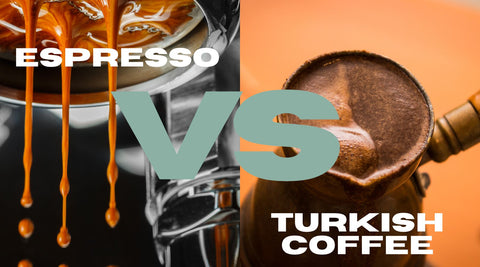Sometimes, an ordinary cup of coffee just isn't strong enough. But what should you drink if you're after a strong coffee kick and a normal drip coffee just won't do it any longer?
The two coffee preparation methods most people will eye are Turkish coffee and espresso. Both of these are concentrated coffees and pack a punch. Both are connected to rich cultural traditions and have unique characteristics that coffee lovers swear by.
But which one is stronger? Before we compare Turkish coffee and espresso in detail, here's a quick answer for more impatient readers.
Quick Answer
The answer depends on a few factors and isn't quite as straightforward as you may want. First of all, the strength of coffee is subjective.
Secondly, it can be influenced by various factors such as brewing method, coffee bean type, grind size, and personal taste preferences.
Thirdly, it depends on how you define strength. Is it the taste or the caffeine content?
So, what’s stronger? Espresso has more caffeine. But both drinks have quite a kick.
To understand the strengths and weaknesses of both options, you'll need to keep reading.
What Is Turkish Coffee?
Turkish coffee originates from the Middle East. This brewing method uses a very fine grind, water, and sugar (optional). The finely ground coffee, often called Turkish coffee grounds, is combined with water and sugar (if you want it sweet) in a special pot called a cezve.
The ground coffee mixture is brewed over low heat. This slow process allows the coffee grounds to settle at the bottom of the cup. The result is a thick and sludgy texture. Because of this, you will usually find some fine coffee grounds in your coffee cup.
Turkish coffee is typically served in a small cup, and you usually have something sweet on the side (e.g., Turkish delight) when drinking Turkish coffee.
What Is Espresso?
On the other hand, espresso hails from Italy and has become the foundation for various coffee drinks worldwide, like cappuccino, cafe latte, mochaccino, and many more.
It is a concentrated coffee brewed in an espresso machine by forcing hot water through fine grounds (not quite as fine as Turkish grounds) under high pressure. The result is a small but mighty shot of espresso. It is known for its bold flavor and rich crema on top. The crema is a foamy layer that adds a velvety touch to the drink.
You will usually not find grounds at the bottom of your cup when you drink an espresso as the grounds remain in the espresso machine. In that way, it's a "cleaner" drinking experience.
What Makes Turkish Coffee Different Than Espresso?
Now that we've briefly introduced Turkish coffee and espresso, let's look at the key differences to understand both coffee drinks' unique characteristics and, eventually, find out which one is stronger.
Turkish Coffee vs Espresso: Coffee Beans
The coffee bean type plays the most important factor in the flavor profile of the final brew. Good Turkish coffee traditionally uses Arabica beans, known for their mild acidity and nuanced flavors.
In contrast, espresso is often made with a blend of Arabica and Robusta beans. Robusta beans bring a robust and bold flavor to the espresso, creating a more intense taste.
However, nothing stops you from using the same beans to make both drinks, as the beans are not the only factor influencing the flavor profile.
Turkish Coffee vs Espresso: Roast Level
How the beans are roasted also impacts the overall strength and flavor. Turkish coffee is typically made with a medium to dark roast. This brings out the coffee's robust and deep taste.
Conversely, espresso is often associated with a dark roast, which brings out bold, intense flavors.
A note of interest: Blonde roasts (i.e., a lighter roast) have recently become more popular for espressos but are still nowhere near as common as darker espresso roasts.
Turkish Coffee vs Espresso: Brewing Equipment
The brewing equipment is one of the main differences between Turkish coffee and espresso. Turkish coffee requires a cezve. This is a small pot with a long handle. It is specifically designed for slow-brewing coffee over low heat.
On the other hand, brewing an espresso shot relies on the more familiar espresso machine, which forces hot water through the coffee grounds at high pressure. For many people, an espresso machine is a rather expensive purchase, so a Cezve might be a more affordable alternative, as these cost far less than good espresso machines.
Both espresso and Turkish coffee require special equipment.
Turkish Coffee vs Espresso: Coffee Brewing Process Time
Patience is a virtue when it comes to Turkish coffee. Turkish coffee preparation is much longer when you compare it to making an espresso drink.
After all, the espresso was invented because someone wanted to get to his cup of coffee faster!
Turkish coffee takes some time because the coffee slowly simmers over low heat. This allows the flavors to mingle and get stronger. Depending on how you prepare Turkish coffee, the brewing process can take anywhere from five to ten minutes.
Espresso is all about speed. The high-pressure brewing process takes only 25 to 30 seconds. The result is a quick but strong shot of coffee.
Grind Size
Turkish coffee requires an extremely fine grind. It is almost as fine as powdered sugar. This fine texture allows the coffee to almost completely dissolve in water.
That's why Turkish coffee has such a thick and sludgy consistency. Espresso is also made with fine espresso grounds which are a bit coarser than Turkish coffee grounds.
Is Turkish Coffee Stronger Than Espresso?
While Turkish coffee and espresso are different in everything from brewing method to grind size, there’s one thing in which they aren’t quite as different: Strength.
Turkish coffee is often described as strong due to its concentrated and robust flavor.
The slow brewing process, fine grind size, and traditional use of Arabica beans contribute to a rich and full-bodied experience. The sludgy texture and unique presentation also add to the perception of strength.
On the other hand, espresso is strong in a different sense. The high-pressure extraction method produces a potent shot with a bold and intense flavor.
The crema, a foamy layer on top of the espresso, adds a velvety texture that enhances the overall experience.
When you look at caffeine levels, espresso is the winner. Turkish coffee contains around 25mg of caffeine per fluid ounce. A typical shot of espresso, on the other hand, contains around 65 mg of caffeine per fluid ounce (single shot). If you want an extra kick and go for a double shot, you'll get a whopping 130 mg of caffeine.
One traditional cup of Turkish coffee is usually 2-4 fluid ounces, so you could consume up to 100mg of caffeine in a cup - but when you look at the actual number per fluid ounce, espresso shots are much stronger.
Which Will You Choose?
The question of which one is stronger only has a definitive answer if you measure strength via caffeine content - then espresso is the clear winner. However, both drinks have a strong, bold, and intense taste.
Thanks to its slow brewing process and unique presentation, Turkish coffee offers a robust and concentrated flavor. The main difference to espresso is the very different mouthfeel.
Thanks to its quick extraction and bold intensity, Espresso provides a different kind of strength. One major difference is that the brewing time of an espresso is much shorter.
The best way to find out which type of strength you prefer is to prepare an espresso and a Turkish coffee and compare them.
Some people will enjoy the clean intensity of the espresso, while other coffee lovers will find the thicker consistency of Turkish coffee more appealing. Both taste good in their own way!



